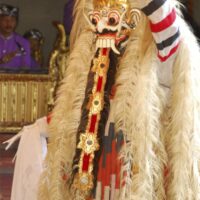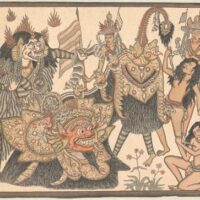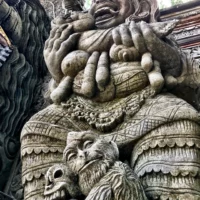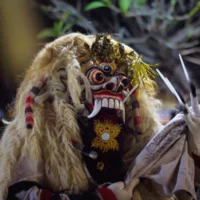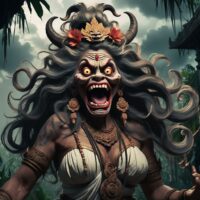Rangda : The Demon Queen
Listen
At a glance
| Description | |
|---|---|
| Origin | Indonesian Mythology |
| Classification | Spirits |
| Family Members | N/A |
| Region | Indonesia |
| Associated With | Child Eating, Shapeshifting, Evil Spirits |
Rangda
Introduction
In Balinese mythology, Rangda stands as one of the most fearsome and captivating figures, revered and feared in equal measure. Known as the demon queen of the Leyaks, she embodies chaos, destruction, and the dark arts, serving as the eternal counterpart to Barong, the benevolent guardian spirit. Her legend is woven into the spiritual and cultural life of Bali, where she is not only a figure of terror but also a crucial symbol in the cosmic balance between good and evil. Rangda’s story blends elements of folklore, history, and religious symbolism, creating a complex character whose presence resonates in ceremonies, dances, and popular imagination.
Physical Traits
Rangda’s appearance is deliberately unsettling, crafted to instill fear and respect. She is depicted as an aged woman, often unclothed, with long, wild hair cascading over her body. Her hands end in long, sharp claws, and her face is a grotesque mask with bulging eyes, a mouth filled with sharp fangs, and a tongue that extends far beyond her lips. Her sagging breasts and skeletal frame are part of a visual language meant to convey her connection to death, decay, and the supernatural. In Balinese performances, this appearance is exaggerated to enhance her role as the embodiment of malevolent forces. Yet, her myth also describes her as a shapeshifter, capable of assuming a form of extraordinary beauty to lure those seeking the secrets of black magic.
Family
The myths surrounding Rangda often intertwine with historical figures and legendary witches. Many stories identify her with Calon Arang, a powerful sorceress from ancient Java whose wrath brought plagues and destruction. Calon Arang’s daughter, Ratna Manggali, was shunned due to her mother’s feared reputation, setting off a chain of vengeance against the kingdom. Another tradition links Rangda to Queen Mahendradatta, the Javanese-born wife of Balinese King Udayana. After being accused of practicing witchcraft and cast into exile, she was said to have embraced dark sorcery and returned to unleash chaos. The Old Javanese and Balinese word “Rangda” translates to “widow,” reinforcing the image of a wronged woman whose grief and anger fuel her supernatural power.
Other names
Rangda is known by several names, each tied to different aspects of her legend. “Calon Arang” refers to the feared witch figure whose tale has been preserved in both oral tradition and written texts. In some contexts, she is hailed as the “Queen of the Leyaks,” a title highlighting her authority over these shape-shifting practitioners of dark magic. Her association with Hindu traditions has led to comparisons with the goddess Durga in her wrathful aspect, as well as with Kali, the destroyer and transformer. These varied titles reflect her multifaceted nature—villainess, goddess, sorceress, and avenger.
Powers and Abilities
Rangda’s powers place her among the most formidable figures in Balinese lore. She is a master of black magic, necromancy, and spiritual warfare. Her dominion over the Leyaks allows her to command spirits capable of possessing humans or animals. She can spread disease, ruin harvests, and summon plagues as weapons of revenge. In myth, she devours children, a horrifying image symbolizing the destruction of innocence. Her ability to shift her appearance enables her to deceive and ensnare those who seek forbidden knowledge. In ritual storytelling, her greatest power is her ability to turn weapons back upon those who wield them, rendering armies helpless in the face of her fury. Rangda’s role is not purely destructive; she represents the forces that must exist to maintain universal balance, embodying the principle that creation and destruction are inseparable.
Modern Day Influence
In contemporary Bali, Rangda remains a living symbol within religious, cultural, and artistic life. Her image is preserved in intricate masks, statues, and temple carvings. The Barong dance, a staple of Balinese performance art, stages the eternal battle between Rangda and Barong, attracting both devotees and visitors. These performances serve as more than entertainment—they are spiritual enactments of “rwa bhineda,” the belief in the coexistence of opposites.
Modern reinterpretations of Rangda have expanded her meaning beyond traditional fear. Some scholars and artists explore her as a representation of female power marginalized by patriarchal systems. The Calon Arang narrative, once seen purely as a cautionary tale of dangerous sorcery, is now sometimes re-read as the story of a widow defending her dignity and her child’s future against societal injustice. Her striking visage has found its way into tattoo art, fashion designs, and even video games, where she appears as a mystical, battle-ready figure.
Despite her frightening reputation, Rangda also holds a place in healing traditions, where rituals invoking her image are believed to help restore spiritual equilibrium. However, suspicion still lingers in parts of Balinese society, where powerful or successful women may be disparagingly called “Rangda,” accused of having dangerous magical abilities. This mix of reverence, fear, and reinterpretation ensures her continued presence in both cultural heritage and evolving artistic expression.
Related Images
Source
Dark Temples. (n.d.). Rangda: The Demon Queen of Balinese Mythology. Retrieved from https://darktemples.com/rangda-the-demon-queen-of-balinese-mythology/
Wikipedia contributors. (n.d.). Rangda. Wikipedia. Retrieved August 15, 2025, from https://en.wikipedia.org/wiki/Rangda
World Mythos. (n.d.). Rangda. Retrieved from https://worldmythos.com/rangda/
The Not So Innocents Abroad. (2018, November 28). The Legend of Rangda, Bali’s Queen of the Demons. Retrieved from https://www.thenotsoinnocentsabroad.com/blog/the-legend-of-rangda-balis-queen-of-the-demons
Bali Trekker. (n.d.). Rangda, The Queen of Leak in Balinese Mythology and Her Battle with Barong. Retrieved from https://balitrekker.com/rangda-the-queen-of-leak-in-balinese-mythology-and-her-battle-with-barong/
Ariati, N. W. P. (2009). The journey of a goddess: Durga in India, Java and Bali.
Brinkgreve, F. (1997). Offerings to Durga and Pretiwi in Bali. Asian Folklore Studies, 56(2), 227–251.
Coldiron, M. (2005). Lions, Witches, and Happy Old Men: Some Parallels between Balinese and Japanese Ritual Masks. Asian Theatre Journal, 22(2), 227–248.
Foley, K. (2022). Bali’s Rangda and Barong in Cosmic Balancing. In The Routledge Handbook of Asian Theatre (pp. 51-64). Routledge.
Foley, K. (2005). Transformation and Aesthetics in Balinese Masked Performances: Rangda and Barong. Asian Theatre Journal, 22(2), 227-248.
Frequently Asked Questions
What is lorem Ipsum?
I am text block. Click edit button to change this text. Lorem ipsum dolor sit amet, consectetur adipiscing elit. Ut elit tellus, luctus nec ullamcorper mattis, pulvinar dapibus leo.
What is lorem Ipsum?
I am text block. Click edit button to change this text. Lorem ipsum dolor sit amet, consectetur adipiscing elit. Ut elit tellus, luctus nec ullamcorper mattis, pulvinar dapibus leo.
What is lorem Ipsum?
I am text block. Click edit button to change this text. Lorem ipsum dolor sit amet, consectetur adipiscing elit. Ut elit tellus, luctus nec ullamcorper mattis, pulvinar dapibus leo.
What is lorem Ipsum?
I am text block. Click edit button to change this text. Lorem ipsum dolor sit amet, consectetur adipiscing elit. Ut elit tellus, luctus nec ullamcorper mattis, pulvinar dapibus leo.
What is lorem Ipsum?
I am text block. Click edit button to change this text. Lorem ipsum dolor sit amet, consectetur adipiscing elit. Ut elit tellus, luctus nec ullamcorper mattis, pulvinar dapibus leo.


